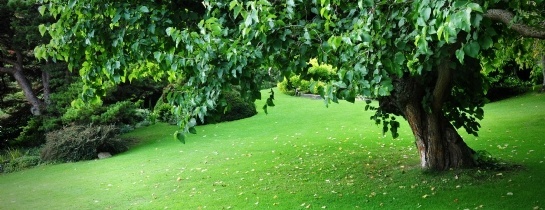
Summer has officially ended. The leaves are changing, jackets and sweaters are coming out of the closet, and pumpkin spice lattes are in. And then...then there's that tree that has been dead since last winter sitting in your front yard. You told yourself you would get it taken care of over the summer, yet there it stands. Maybe you can dress it up with Christmas lights until spring.
Don't fret; it's common to forget. In fact, there are really only two times of the year that we truly pay attention to our lawn, autumn and spring. With autumn in full swing and the leaves covering your yard, what should you do about that tree?
The Case of the Troublesome Tree
Even if that tree in your yard isn't dead, you might still have a desire to cut it down. It could be an eyesore or a danger. So how should you deal with it? Let it rot from the inside and fall over, potentially landing on your home, car, or even a person? I think we can agree that's not a good idea, particularly if it's a rather large tree.
Tree removal usually involves stages. First, the tree must be and surrounding area must be prepped. Second, the tree must be safely cut down. Third, the stump that remains will need to be removed. Preparation is going to look something like this:
- Check for Other Trees: A falling tree can cause a domino effect if there are other trees in its path. Consider surrounding trees and prune the troublesome tree down prior to cutting it from the base.
- Check the Lean: If the tree leans at all, you'll want to make sure the cut allows it to fall the way of its lean.This will minimize the size of the cut necessary to bring it down safely.
- Clear the Undergrowth:Any branches or underbrush can hinder your movement. Clear the undergrowth first to maximize movability. While you're at it, clear away any lower branches or buttresses with your chainsaw. Remember; never cut anything higher than your shoulder as it's an unsafe way to operate a chainsaw.
Once you've handled the preparations, you're ready to take the tree down. Cutting down a tree—especially a large one—is a dangerous mission. If you're not experienced, we recommend seeking out a professional in your local area. They can even tackle the preparation for you.
Uprooting the Stump
Cutting down an unhealthy or unwanted tree solves a problem, but it creates a new one. Now there's a big, unsightly stump in the middle of your yard. That unsightly stump can make lawn work twice as hard as you attempt to navigate the mower and weed whacker around it. It can even cause problems if you have children who like to run and play in the yard. So how do you get rid of it?
Stumps removal can be perplexing for any homeowner. Luckily, there are five methods at your disposal for removing the stump:
- Dig It Out By Hand: This is ideal for stumps that have a relatively small diameter and shallow roots. It doesn't require a lot of tools. An axe, a shovel, a root saw, a lopper, and some elbow grease coupled with determination are all you need.
- A Stump Grinder:A stump grinder is a piece of heavy machinery designed to chew away stumps up to 12 inches below ground level. It can make short work on an unsightly stump, but you need to be careful when operating it. If it gets out of control or the stump is near buried pipes, it could cause damage.
- A Backhoe: This is the most expensive and messy removal method. While a backhoe will pop the stump out of your yard, it will likely tear up your lawn in the process. Unless you have a number of stumps to remove, it's not a recommended method for the homeowner.
- Chemicals:Generally, this method uses potassium nitrate to speed up the decay of the stump. While it will result in the eventual end of that stump, it will take months of regular application.
- Fire: Sometimes scrap wood is used to start or maintain fires on stumps to remove them. It's environmentally friendly, and you can have a mini bonfire in the process, making it the most social removal method. Just check with your city about when it's okay to burn.
If you hired a professional to cut the troublesome tree down, chances are they'll be ready and able to remove the leftover stump. They'll likely employ one of these same methods.
You can tend to your trees on your own, but tree and stump removal is only recommended for the dedicated do-it-yourselfer. Should you choose to tackle the project on your own, be sure to follow safety protocols and have a partner on site in case anything unpredicted transpires.
Posted by: TrustedPros



